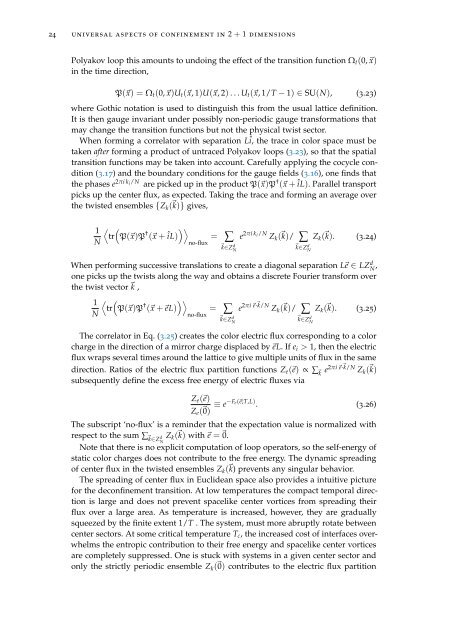Topology, symmetry, and phase transitions in lattice gauge ... - tuprints
Topology, symmetry, and phase transitions in lattice gauge ... - tuprints
Topology, symmetry, and phase transitions in lattice gauge ... - tuprints
You also want an ePaper? Increase the reach of your titles
YUMPU automatically turns print PDFs into web optimized ePapers that Google loves.
24 universal aspects of conf<strong>in</strong>ement <strong>in</strong> 2 + 1 dimensions<br />
Polyakov loop this amounts to undo<strong>in</strong>g the effect of the transition function Ω t (0,⃗x)<br />
<strong>in</strong> the time direction,<br />
P(⃗x) = Ω t (0,⃗x)U t (⃗x, 1)U(⃗x, 2) . . . U t (⃗x, 1/T − 1) ∈ SU(N), (3.23)<br />
where Gothic notation is used to dist<strong>in</strong>guish this from the usual <strong>lattice</strong> def<strong>in</strong>ition.<br />
It is then <strong>gauge</strong> <strong>in</strong>variant under possibly non-periodic <strong>gauge</strong> transformations that<br />
may change the transition functions but not the physical twist sector.<br />
When form<strong>in</strong>g a correlator with separation Lî, the trace <strong>in</strong> color space must be<br />
taken after form<strong>in</strong>g a product of untraced Polyakov loops (3.23), so that the spatial<br />
transition functions may be taken <strong>in</strong>to account. Carefully apply<strong>in</strong>g the cocycle condition<br />
(3.17) <strong>and</strong> the boundary conditions for the <strong>gauge</strong> fields (3.16), one f<strong>in</strong>ds that<br />
the <strong>phase</strong>s e 2πi k i/N are picked up <strong>in</strong> the product P(⃗x)P † (⃗x + îL). Parallel transport<br />
picks up the center flux, as expected. Tak<strong>in</strong>g the trace <strong>and</strong> form<strong>in</strong>g an average over<br />
the twisted ensembles {Z k (⃗ k)} gives,<br />
1<br />
〈 (<br />
)〉<br />
tr P(⃗x)P † (⃗x + îL)<br />
N<br />
=<br />
no-flux<br />
∑<br />
⃗ k∈Z d<br />
N<br />
e 2πi k i/N Z k (⃗ k)/ ∑<br />
⃗ k∈Z d<br />
N<br />
Z k (⃗ k). (3.24)<br />
When perform<strong>in</strong>g successive translations to create a diagonal separation L⃗e ∈ LZ d N ,<br />
one picks up the twists along the way <strong>and</strong> obta<strong>in</strong>s a discrete Fourier transform over<br />
the twist vector⃗ k ,<br />
1<br />
〈 (<br />
)〉<br />
tr P(⃗x)P † (⃗x +⃗eL)<br />
N<br />
=<br />
no-flux<br />
∑<br />
⃗ k∈Z d<br />
N<br />
e 2πi ⃗e·⃗ k/N<br />
Z k (⃗ k)/ ∑<br />
⃗ k∈Z d<br />
N<br />
Z k (⃗ k). (3.25)<br />
The correlator <strong>in</strong> Eq. (3.25) creates the color electric flux correspond<strong>in</strong>g to a color<br />
charge <strong>in</strong> the direction of a mirror charge displaced by⃗eL. If e i > 1, then the electric<br />
flux wraps several times around the <strong>lattice</strong> to give multiple units of flux <strong>in</strong> the same<br />
direction. Ratios of the electric flux partition functions Z e (⃗e) ∝ ∑ ⃗k e 2πi ⃗e·⃗ k/N<br />
Z k (⃗ k)<br />
subsequently def<strong>in</strong>e the excess free energy of electric fluxes via<br />
Z e (⃗e)<br />
Z e (⃗0) ≡ e−F e(⃗e;T,L) . (3.26)<br />
The subscript ‘no-flux’ is a rem<strong>in</strong>der that the expectation value is normalized with<br />
respect to the sum ∑ ⃗k∈Z d<br />
N<br />
Z k (⃗ k) with ⃗e = ⃗0.<br />
Note that there is no explicit computation of loop operators, so the self-energy of<br />
static color charges does not contribute to the free energy. The dynamic spread<strong>in</strong>g<br />
of center flux <strong>in</strong> the twisted ensembles Z k (⃗ k) prevents any s<strong>in</strong>gular behavior.<br />
The spread<strong>in</strong>g of center flux <strong>in</strong> Euclidean space also provides a <strong>in</strong>tuitive picture<br />
for the deconf<strong>in</strong>ement transition. At low temperatures the compact temporal direction<br />
is large <strong>and</strong> does not prevent spacelike center vortices from spread<strong>in</strong>g their<br />
flux over a large area. As temperature is <strong>in</strong>creased, however, they are gradually<br />
squeezed by the f<strong>in</strong>ite extent 1/T . The system, must more abruptly rotate between<br />
center sectors. At some critical temperature T c , the <strong>in</strong>creased cost of <strong>in</strong>terfaces overwhelms<br />
the entropic contribution to their free energy <strong>and</strong> spacelike center vortices<br />
are completely suppressed. One is stuck with systems <strong>in</strong> a given center sector <strong>and</strong><br />
only the strictly periodic ensemble Z k (⃗0) contributes to the electric flux partition
















